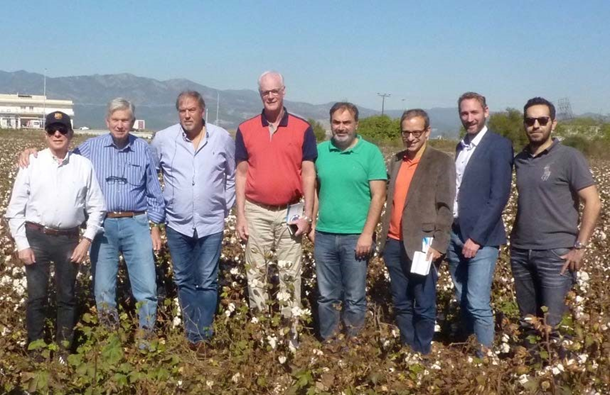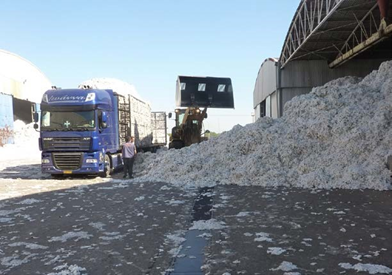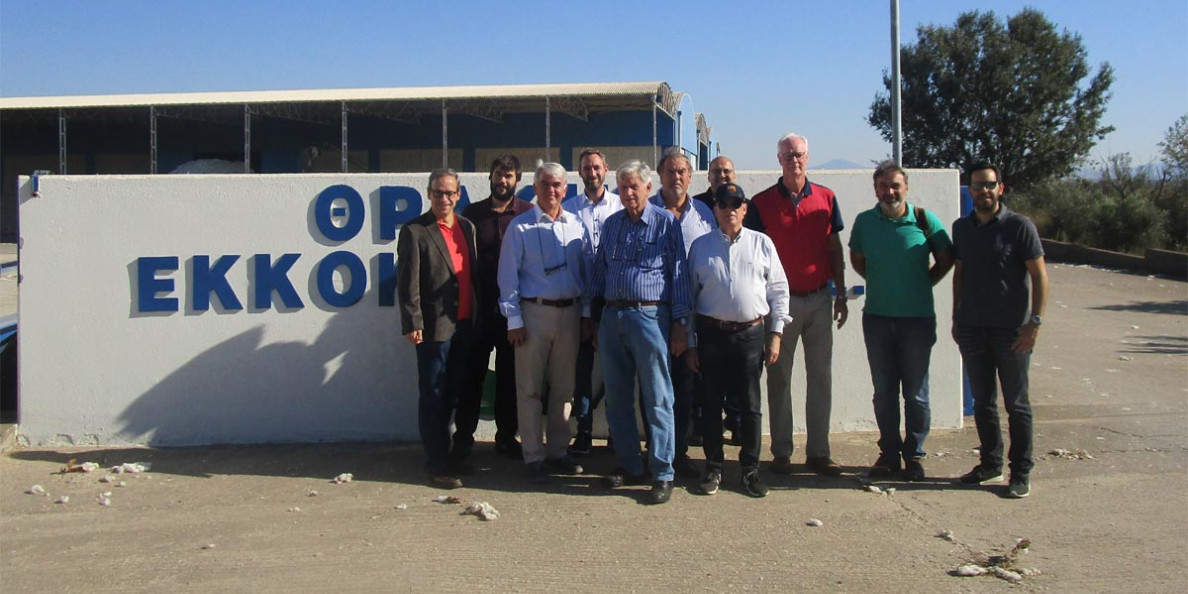INTERNATIONAL TEXTILE MANUFACTURERS FEDERATION
Spinners Committee
From October 13-16, 2019 the ITMF Spinners Committee visited Greece on behalf of ITMF, as part of the on-going program of the Committee to visit cotton-producing countries around the world in an effort to strengthen the dialogue in the cotton pipeline between growers, ginners, seed breeders and cotton spinners
Objectives of the visit
- To review the situation of cotton growing and ginning in Greece
- To evaluate current cotton quality in the fields and harvesting
- To evaluate the ginning today, based on world standards
- To evaluate and discuss the road to sustainably and traceability in cotton
- To evaluate the cotton classing systems
- To discuss the future of cotton programs in Greece
 F.l.t.r.: Walter Simeoni, Andrew Macdonald, Damase Büchi, Enrique Crouse, Thomas Nasiou, Christian Schindler, Olivier Zieschank, Yiannis Papadogiannis
F.l.t.r.: Walter Simeoni, Andrew Macdonald, Damase Büchi, Enrique Crouse, Thomas Nasiou, Christian Schindler, Olivier Zieschank, Yiannis Papadogiannis
Greek cotton industry – background and facts
Looking back, Greece’s peak cotton production was in the early 2000’s with a production of around 450’000 tons of ginned cotton. In 2006, the EU decided to separate the subsidies from the production and instead applying them to area, known as “decoupled”. This led to a decline in cotton production. Together with the decline in production the cotton quality also suffered, mainly due to this alteration of the incentives.
Greece is the 10th larger cotton producer and the 5th larger exporter of cotton in the world. During this season, Greece’s cotton production is expected to reach around 330’000 – 350’000 tons of ginned cotton. Especially this year, the weather conditions helped not only to reach a high yield (between 3’500kg/hectare to 5’000kg/hectare or more of seed cotton) but also a very good quality.
A characteristic of the Greek cotton production is that the farmers own or rent land and cultivate mainly relatively small fields (indicative size is 3 to 10 hectares). This inhibits large-scale cultivation practices. The farmers deliver the seed cotton to the gins and are paid at that time, based on the equivalent international cotton prices for the quantity and moisture content. From then on the ginners are the owners of the ginned cotton, and sell it either directly to spinning mills, or through international traders This constellation makes the adaption of nation-wide programs easier as their implementation is centralized (through the ginners and their relations with the growers) and executed locally.
Greek cotton is mainly medium staple (28-29.5mm), with micronaire (3.9-4.5), strength averaging between, 30-31g/tex, and with good uniformity. Almost all the production is irrigated, but until now only a small percentage by drip irrigation, the cotton is machine-harvested, and saw ginned.
At harvest time the process of defoliation does not appear to be a standard practice due to various factors. This is because in general the Greek farmers are picking with their machines, twice even three times, an uncommon practice compared to other machine harvesting countries. With the slow maturing plants, they attempt, through the spindle settings and harvesting speed, to pick the mature bolls and leave enough bolls to open for the second picking. It is estimated that the first pick leaves about 20% behind for the second. Therefore, in those cases where it is applied, the defoliation is light to allow the plants to complete the cycle for the second picking. In most countries the cost of a second pick is too expensive, clearly in Greece this is not the case, Weather is also a consideration in this process of defoliation as they would be able to harvest only 12 days after the defoliation and with the unstable weather conditions this is an extra consideration, as to when, and if to decide to spray the application However it was noted that if the farmers are producing seed cotton for sowing seed then they are obliged to defoliate to avoid as much trash as possible in the cotton seed.
Climate change has been a factor in many regions effecting the availability of water for irrigation. It has been observed that the salt content in the ground water increased in some areas close to the sea even when pumped from 200m depth. The average temperatures have also increased over time.
The ginning machinery in Greece is relatively new and of high production, but those visited working with reduced speeds and output to help preserve the good quality characteristics of the cotton. The production rate per gin stand varies between 5-10 bales per hour, and all bales weight around 220-230kg and are marked with a unique ID, indicating the production date, place and bale number, with a fibre outturn of between 33 and 36%.
In recent years, both the production as well as the yield and the quality of the cotton has improved. The main changes over the last 5 years are:
- Study and publication of the results of the various cotton seed varieties, in terms of yield and quality. Based on these, some of the ginners created premium schemes, called for example ‘Cotton+ and “Best Fibre CFS” for certain varieties. This process has helped to streamline and reduce the varieties cultivated, and today only about 10 varieties produce around 80% of the volume.
- Homogeneity and uniformity of the cotton, because of the fewer varieties used, as well as improvement of the farming practices and the irrigation of the cotton fields, the quality of the Greek cotton has improved also in this respect
As far as the actual ginning of the cotton it was clear to the Committee from the gins visited that good cotton ginning practices are being followed, which goes a long way maintaining the excellent characteristics of the Greek cotton
In the last couple of years, the Hellenic Cotton Association has been very active in many areas. One major initiative is the creation of the European Cotton Alliance, together with the Spanish cotton and textile association. The alliance’s aim is to give an identity to the cotton produced in the EU, to bring together all the cotton related industries and people from the EU and to promote the value of the product. The main dimensions of the cotton from EU are its sustainability (non-GMO, socially responsible produced cotton), quality, traceability and transparency.
Some ginners have implemented various incentive schemes to increase the value of the cotton also for the growers. An example of this has been the formation of CSF program (Certified Sustainable Fibermax), a program which in this case is set up in cooperation with BASF, and provides the farmers a full set of services including soil analysis, weather monitoring to optimize irrigation and the use of fertilizers as well as technical support from agronomic experts. The aim is to increase the yield in a sustainable way and to support the growers by offering higher prices for certain quality levels.
The other activity is the alignment of the official “production protocol” in Greece with those “items” used by BCI. It was understood that this will allow Greek cotton production to be included and certified under the BCI program. This is expected to take place soon, hopefully already in 2020 at a national level. BCI today being a recognised cotton sustainability program will benefit the ginners and through them, the farmers. The spinners facing requests from the retailers for BCI cotton products will also be benefited
Another initiative is to provide incentives to encourage the growers to bring the seed cotton with the correct moisture to the gin.
Monday, 14 October 2019 (Thrakika Ekkokkistiria - Komotini)

From Thessaloniki the Committee travelled by van to Komotini in the East of the country, where the members visited the Thrakika Ginning mills and met with Mr. Kouroudis. Mr. Kouroudis and his family are in cotton ginning business for two generations and are fully and passionately involved in the daily business. Mr. Kouroudis is a visionary person always trying to innovate. He has created the “Cotton +” brand (which comprises 30% of his production) and is orchestrating and supporting the CSF program (Certified Sustainable Fibermax) from the farmers and ginners side.
The main attributes of the “Cotton +” brand are:
- Restricted cotton seed varieties with known good quality characteristics and with high yields,
- Classification of seed cotton, for lot separation to optimize the ginning,
- Certification, traceability and sustainable production practices
- A remuneration incentives scheme for the farmers
The implementation, control and certification of this program is undertaken by 3rd parties and external agriculture auditors, namely AIFORIKI and QMSCERT. The program involved 240 growers in the last season and produced 9’300 cotton bales.
Mr. Kouroudis is involved in other initiatives to create win-win conditions for the whole ecosystem of cotton in the area of Komotini. He is also working with retailers with the objective to increase the level of sustainability of the Greek cotton.
This year, he was asked for the first time by a brand/retailer to use tracers/markers in the cotton bales he is producing. Currently a part of the production is working on a trial basis, using the tracer Tailorlux to enable the traceability of the cotton though out the industrial chain.
The Committee visited an experimental cotton field adjacent to the gin which was ready for harvesting and all the varieties showed excellent quality, and potential for a good outturn.
The seed cotton currently in the patio showed no evident foreign matter and for machine cotton was remarkably clean.
During the visit the Committee had the opportunity to visit the cotton gin, four stands of Consulted Feed Master 96 with 164 saws, and using an impact lint cleaner, Clearly the gin is well managed, running at well below capacity with a soft roll in ensure the maximum preservation of the quality. The bales are HD pressed and covered in blue polyethylene wrapper, which though better than woven polyester bagging still left the risk for contamination with the movement of the bales by fork lifters cutting the wrapping.
Thrakika Ekkokkistiria: Pictures from the visit
Source: ITMF


